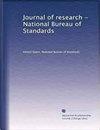Evolutionary Factor Analysis
Journal of research of the National Bureau of Standards
Pub Date : 1988-05-01
DOI:10.6028/jres.093.035
引用次数: 7
Abstract
Because of chemical interconversion, many chemical systems cannot be physically separated, making chemical identification and quantification difficult. The spectra (IR, UV, Visible, Raman, CD, etc.) of such systems exhibit overlapping contributions of uncataloged components, confounding the identification as well as the quantification. Strategies based on factor analysis [1], a chemometric technique for handling complex multi-dimensional problems, are ideally suited to such problems. Abstract factor analysis (AFA) reveals the number of spectroscopically visible components. Evolutionary factor analysis (EFA) [2-4] takes advantage of experimental variables that control the evolution of components, revealing not only the concentration profiles of the components but also their spectra even when there are no unique concentrations or spectral regions. Evolutionary factor analysis makes use of the fact that each species has a single, unique maximum in its evolutionary concentration distribution curve. We have recently applied this self-modeling method to the infrared spectra of stearyl alcohol in carbon tetrachloride solution. The evolutionary process of this system was achieved by increasing the concentration of stearyl alcohol from 0.0090 to 0.0800 g/L in 15 stages, each time recording the IR spectra from 3206 to 3826 cm '. The spectra were corrected for baseline shift, solvent absorption and reflectance losses. The 15 spectra were then digitized every 3 cm ' and assembled into a 35 x 15 absorbance matrix [A] appropriate for factor analysis. The factor indicator function [1], the reduced eigenvalue [5] and cross validation [6] indicated that three species contribute to the observed spectra. Thus AFA expresses the data matrix as a product of a 35 x 3 absorptivity matrix [E],,,, and 3 X 15 abstract concentration matrix [C],h,,.进化因素分析
由于化学相互转化,许多化学体系不能物理分离,给化学鉴定和定量带来困难。这些系统的光谱(红外、紫外、可见光、拉曼、CD等)显示出未编目成分的重叠贡献,使鉴定和定量混淆。基于因子分析(一种处理复杂多维问题的化学计量学技术)的策略非常适合这类问题。因子分析(AFA)揭示了光谱可见组分的数量。演化因子分析(Evolutionary factor analysis, EFA)[2-4]利用控制组分演化的实验变量,不仅揭示组分的浓度分布,而且在没有特定浓度或光谱区域的情况下也能揭示其光谱。进化因素分析利用了这样一个事实,即每个物种在其进化浓度分布曲线上都有一个唯一的最大值。我们最近将这种自建模方法应用于硬脂醇在四氯化碳溶液中的红外光谱。系统的演化过程是通过将硬脂醇浓度从0.0090 g/L增加到0.0800 g/L,分15个阶段完成的,每个阶段记录的红外光谱范围为3206 ~ 3826 cm’。对光谱进行了基线偏移、溶剂吸收和反射损失校正。然后每3 cm '对15个光谱进行数字化,并组装成适合因子分析的35 x 15吸光度矩阵[a]。因子指示函数[1]、特征值约化[5]和交叉验证[6]表明三个物种对观测光谱有贡献。因此,AFA将数据矩阵表示为35 × 3吸收率矩阵[E],,,,与3 × 15抽象浓度矩阵[C]的乘积,h,,。
本文章由计算机程序翻译,如有差异,请以英文原文为准。
求助全文
约1分钟内获得全文
求助全文

 求助内容:
求助内容: 应助结果提醒方式:
应助结果提醒方式:


